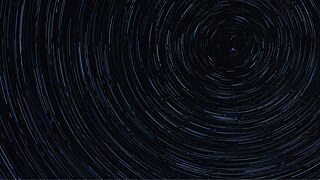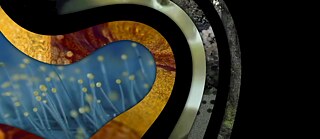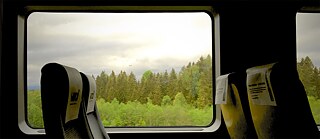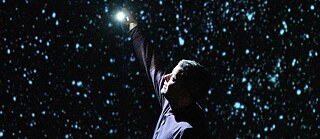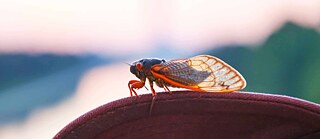Eine Klangwanderung
Sounds of Nature
Tosca Terán übersetzt digital das Wachstum von Pilzen in Klanglandschaften. In dieser Folge nimmt die kanadische Künstlerin die Zuhörer*innen mit auf einen Audiospaziergang. Unterbrochen wird dieses virtuelle Erlebnis von Interviews mit anderen Klangkünstler*innen, die Töne und Geräusche der Natur in immersive Klangwelten verwandeln.
Diese Folge anhören: Apple Music | Spotify | Download
Dieses Hörerlebnis stammt von Tosca Terán, eine interdisziplinäre Künstlerin, die durch sogenannte „Sonifikation“ die Biodaten von Pilzen digital erfasst und in immersive Klangwelten übersetzt. Bisher waren ihre Arbeiten ausgestellt im MOCA Toronto, The Ontario Science Centre, und im Rahmen des Raindance Film Festivals. Mehr ist über sie und ihre Arbeit auf ihrer Webseite zu erfahren. In dieser Folge sprechen außerdem die Klangkünstler*innen Penelope Walcott, Leslie Garcia und Paloma Lopez vom Künstler*innen-Kollektiv Interspecifics Collective, sowie Andrea Polli, und Hildegard Westkamp über ihre Arbeit. Die Musik dieser Folge stammt von den beteiligten Künstler*innen. Das Titelbild zur Folge stammt von Tosca Terán.
Transkript
[EDITOR’S NOTE: THIS EPISODE IS PRODUCED FOR THE EAR AND DESIGNED TO BE LISTENED TO WHILE WEARING HEADPHONES. IF YOU CAN, WE STRONGLY ENCOURAGE YOU TO LISTEN TO THE AUDIO, WHICH INCLUDES SPOKEN WORD SOUND OVERLAYS, EMOTION, AND EMPHASIS THAT CANNOT BE TRANSFERRED ONTO THE PAGE.]
[MUSIC]
Tosca Terán: What you are currently listening to is the sound of living mycelium playing a synthesizer. [MYCELIUM MUSIC] Mycelium is the vegetative part of a fungus or fungus-like bacterial colony. Consisting of a mass of branching, thread-like hypha. [MYCELIUM MUSIC] My name is Tosca Terán. I create music with fungi and work with mycelium. Today, I will take you on a soundwalk through subjects that interest me: bio-sonification, field recording, and sound ecology. A soundwalk sharing different sound worlds and sound as a medium to reflect on our shared, multi-species environment. [MYCELIUM MUSIC] Sound, when understood as an environment, is a soundscape, a powerful tool that helps humans relate to their surroundings.
[MYCELIUM MUSIC FADES INTO MACHINE SOUNDS]
Penelope Walcott: When I listen to machine sounds, what I hear is a type of music.
Tosca Terán: Penelope Walcott is a sound designer who works with sounds collected from industrial machinery.
[MACHINES MOVING, A PERSON HOWLING IN A CONSTRUCTION ZONE]
Tosca Terán: Penelope is collaborating with me to create the sonic ecology within the “Symbiosis/Dysbiosis” project.
Penelope Walcott: When we think of the natural environment, we think of nature. We think of the stuff that’s not manmade. And so for me, my way into “Symbiosis/Dysbiosis” is machines are, were made, were created, invented by people, people are a part of nature; therefore, machines are also a part of nature as we are, as music is.
[MACHINE AND STREET SOUNDS]
Tosca Terán: “Symbiosis/Dysbiosis” is a fully immersive, mixed reality experience working with field recordings and living mycelium biodata-sonification. I presented “Symbiosis/Dysbiosis” during the Goethe-Institut Montreal’s New Nature Climate Science Exchange in May 2020.
Penelope Walcott: Ecology is anything that we interact with in the environment. We live in a city, or rather if we talk about living in a remote environment, then it’s about how we relate to the flora and fauna that surrounds us, how we manage it, how we engage with it. It’s the same thing in the city; there are just slightly more levels. There’s less flora and fauna, but there’s the sound, there are the cars, there are the other people we have to deal with, there’s transportation. There are all these things that build a particular type of ecology.
[MACHINE SOUNDS DISSOLVE INTO PERCUSSIVE BIODATA SOUNDS]
Tosca Terán: [SPEAKING OVER SOUNDS] Wikipedia describes ‘sonification’ as the use of non-speech audio to convey information or perceptualize data. And I’m thinking about Leslie Garcia and Paloma Lopez of the Interspecifics Collective and their term, ‘bio-sonification’ that I stumbled upon in 2016.
[MUSIC CREATED BY THE INTERSPECIFICS COLLECTIVE DERIVED FROM PHYSARUM POLYCEPHALUM, A UNICELLULAR SLIME MOLD]
Leslie Garcia: It is not only humans that are capable to generate bio-electrical energy. There are other organisms, and bio-electrical energy ends up being like some sort of like universal language, in a sense. So, the idea of bio-sonification was to use the same concepts of influence, control, and correlation to produce a system that performs on the bio-electrical activity of several organisms and enables them to have an interface. To express their materiality to sound.
Tosca Terán: [SPEAKING OVER PHYSARUM MUSIC] The Myxomycetes, or slime molds, are a group of ameboid protists considered for many years as a special group of fungi.
Paloma Lopez: It started with Physarum. Because before that, we were just looking at plants and bacteria, and it was kind of easy to follow the data. And once we started looking at Physarum, it was really complicated, and it was when we started needing some digital help.
Leslie Garcia: But more in the sense of their own materiality, and this is something we take from the Latin American cultures in general, the way our ancestors perceive nature. It’s a way of interconnected intelligence and elevated perception, so we try to approach them from this particular point of view and consider them as important as their human contra-parts in the process of work.
Paloma Lopez: We chose sound as the communication bridge. Make us understand all these invisible phenomena that we are not able to grasp.
[PHYSARUM MUSIC]
Paloma Lopez: We share lots of characteristics with the environment. That gives you a lot, that has given me a lot of insight on my position in the universe, and I appreciate a lot more. Every detail of it.
Leslie Garcia: Maybe we could collect a symbiotic relation in that way. Like symbiotic processes describe this way of collaborating we are trying to approach from our work. They are embedded in the narrative of life. If we start knowing ... You know, at this time, it’s a new paradigm, in a way.
[PHYSARUM MUSIC]
Leslie Garcia: It’s like you gain the perspective of the other. [PHYSARUM MUSIC] We started, you know, with this signal analysis with bio-electrical organisms, and then, we realize that we have a lot of questions on the patterns emerging there. So, we sort of move into pattern-looking algorithms to analyze those signals. And then, that take us to machine learning to be able to explore further those emergences and events inside the phenomena we were observing, and we are there right now. We are sticking to, you know, working together with artificial intelligence, trying to understand artificial intelligence not as a utilitarian algorithm but also as an agency capable of creative processes and trying to find ways of influence the systems together with our information and perspectives.
[PHYSARUM MUSIC FADES INTO ML COLLABORATIVE MUSIC, WHICH FADES INTO FOOTSTEPS CRUNCHING ON ICE]
Tosca Terán: In soundscape studies, ‘keynote sounds’ are those which are heard enough to form a background against which other sounds are perceived. Often, keynote sounds are not consciously perceived, but they act as conditioning agents in the perception of other sound signals. And I’m thinking of artist Andrea Polli who went in search of the keynote during an artist residency in Antarctica. There, she interviewed scientists and recorded her time at Taylor Glacier.
Andrea Polli: You know, it’s really rare to be able to hear a keynote. I had always been really fascinated by it. And one day, I decided to go on a hike. And I got my PowerBars and got as far away from the camp as I could and started recording. And I heard, as I was recording, what sounded like kind of a high-pitched sound. I’m recording this, and I’m looking at these beautiful, incredible mountains and glaciers surrounding me. And just a completely silent place, and I thought, wow, how cool and how wild that these mountains are sounding like this high-pitched sound, and it’s so weird. And I got really excited and recorded a lot actually [LAUGHS] and got back to camp, where I had my computer and my little setup, and I was gonna listen to it again. And I got it into my computer, and I didn’t hear anything. I looked at the recording image too, and you know, there really wasn’t ... you know, except for a few kind of wind noise at times, you know. That high pitch, it wasn’t there. And I got back to New York, and I was, my friend said, hey, it’s what John Cage talked about, it’s the sound of your nervous system.
[WIND BLOWING FADES INTO ELECTRONIC DATA-SONIFICATION]
Tosca Terán: [SPEAKING OVER DATA-SONIFICATION] Andrea Polli sculpts data into sound while interspersing interviews she’s conducted with climate scientists.
[DATA-SONIFICATION SOUNDS]
Scientist #1: There’s definitely gonna be shifts. And you know, in those shifts, some places are going to be better places to live, but places are going to be worse to live. And it’s going to be a re-organization of human civilization.
[DATA-SONIFICATION SOUNDS FADE INTO WATER RUSHING]
Scientist #2: I have to admit that I was shocked. I was shocked with, by finding how sensitive many ecosystems are and how much they could be impacted by climate change in the future. And so, I felt actually myself — again, as a citizen, as an individual, as a human being — an obligation to tell other people who are willing to listen and who are interested in this topic — and I believe everybody should be, by the way — it’s their life!
[DATA-SONIFICATION FADES INTO GURGLING WATER SOUNDS]
Andrea Polli: I’ve been doing a lot of research into how nature experiences affect people, and specifically, affect people positively. And there’s an aspect of nature experience that is defined as vibrancy, and I really like that. It’s like light on the surface of water, kind of moving in a very beautiful way or light coming through leaves that are moving. That vibrancy that we get in nature that we don’t really get in a built environment.
[DATA-SONIFICATION SOUNDS WITH GURGLING WATER SOUNDS, NOW LOWERING IN PITCH]
Tosca Terán: Soundscapes can be made to inform the listener, they can sonically share data, and they also, like all music, can elicit an emotional response.
[WATER FADES INTO PERCUSSIVE ECHOING SOUNDSCAPE AND AN EXCERPT FROM “THE SOUNDSCAPE SPEAKS”]
Hildegard Westkamp: [WATER DRIPPING, CHORAL SOUNDING VOICES, HILDEGARD’S VOICE WITH PIPE ECHOING PERCUSSIVE SOUNDS] It’s Saturday, just around noon, February 15, 1992. The pipe captures all sounds and transforms them.
Tosca Terán: The definition of ‘ecologist’ is a person who studies the natural relationships between the air, land, water, animals, plants or a scientist who studies how animals and plants interact with their environment. And I’m thinking about Hildegard Westerkamp who refers to herself as a ‘sound ecologist’ and what sound ecology means to her.
[MUSIC FROM “THE SOUNDSCAPE SPEAKS”]
Hildegard Westerkamp: It really has to do with being one of many people to attend to the issues of soundscape. The issues of the sound environment. The quality of the sounds that we put out there and — as societies, as individuals — wanting to learn to become responsible as sound makers and listeners, equally in this world.
[MUSIC FROM “THE SOUNDSCAPE SPEAKS”]
Tosca Terán: Listening with someone else’s ears. I think of non-human flora and fauna and funga and their perception of our shared environment.
Hildegard Westerkamp: There are different ears out there. When we do soundwalks, I mean, I’ve done so many soundwalks over the years, and in the discussions afterwards, you realize that every human being hears differently. Absolutely. Psychologically. Physically. And this may come out in a discussion, where that person has heard that whole entire soundwalk completely differently than anybody else. Or psychologically speaking, one person may have noticed a sound that the other person completely ignored. So, that’s among humans. That’s the social kind of difference in ears. So, I think we can extend that and say, of course, every being in this world — every animal, every plant, everything — perceives the world through its own organs. And I think it’s a really important place to become aware of, especially nowadays. We absolutely need to stand back as human beings and imagine what the rest of living beings on this earth perceive and how they survive, how they fit into the entire system. And you know, I mean biologists, scientists, everybody has worked on this ecologically already for years and has warned us of what’s happening.
[MUSIC FROM “THE SOUNDSCAPE SPEAKS,” TRAIN HORN FADING IN DISTANCE, HUMAN VOICES, WATER WITH BIRD WINGS FLUTTERING]
Hildegard Westerkamp: [VOICE TRAVELING FROM LEFT TO RIGHT] Slow down for a moment. Imagine moving through a day of your life listening with someone else’s ears. Very special to give yourself time to listen to the environment like that, and of course, soundwalks do exactly that. They invite you to listen for longer times and the point is that the longer you listen, the more you get immersed. Slow down for a moment, and make time for listening.
Tosca Terán: ‘Clairaudience.’ Hearing something that is not present to the ear but regarded as having objective reality. In pursuit of clairaudience.
Hildegard Westerkamp: Simply speaking, it actually just means, clear hearing. And if we just stick to that term, clear hearing involves more than just listening to sounds. It really refers to hearing everything that belongs to a sound. Its place, its body, its tone, its length of time, its message. Its entire context. So, clairaudience on that level is very much clear hearing the reality around you. The sounds emerge. It has gotten quite important to be conscious of disappearing sounds, just as we have to be conscious of disappearing species.
[MUSIC FROM “THE SOUNDSCAPE SPEAKS,” WATER FLOWING, TWIGS SNAPPING, SEAGULLS, BIRDS TWITTERING]
Hildegard Westerkamp: I’m going to lead you through this part today, but in a rather different way this time. [SOUNDS OF WATER FLOWING] Emily Carr used to paint the B.C. [EDITOR’S NOTE: BRITISH COLUMBIA] forest. With her words, I will lead you through this forest today. [SOUNDS OF WATER FLOWING, BIRD SOUNDS] Nothing is still now, life is sweeping through the spaces. Everything is alive. The air is alive. The silence is full of sound.
[BIRDS SINGING, WATER FLOWING IN THE DISTANCE, WINGS FLUTTERING; FADES INTO BIO-SONIFICATION]
Tosca Terán: I would like to dedicate this episode to the memory of Canadian composer R. Murray Schafer. [BIO-SONIFICATION MUSIC] I would like to thank you for joining me on today’s soundwalk. I would like to extend big thanks to the artists Penelope Walcott, Leslie Garcia and Paloma Lopez, Andrea Polli, and Hildegard Westerkamp for sharing their work and process with us. Please refer to the episode notes for links to the artists’ works and to learn more about them. [BIO-SONIFICATION MUSIC] Today’s soundwalk was created by myself, Tosca Terán, with production assistance from Nancy Pettinicchio and final mix-down by Antonin Wyss. [BIO-SONIFICATION MUSIC] What you are listening to is Agathis australis, commonly known by its Māori name ‘Kauri.’ I recorded Kauri biodata-sonification during a visit to the Arataki Visitor’s Centre in Titirangi, New Zealand, 2019. During my recordings, I met Māori ranger Joc. Joc told me that the sounds she was hearing from the Kauri could be referred to as ‘Rongoā.’ Healing, feeling, cleansing. I leave you, dear listeners, with Rongoā.
[KAURI BIO-SONIFICATION MUSIC]

